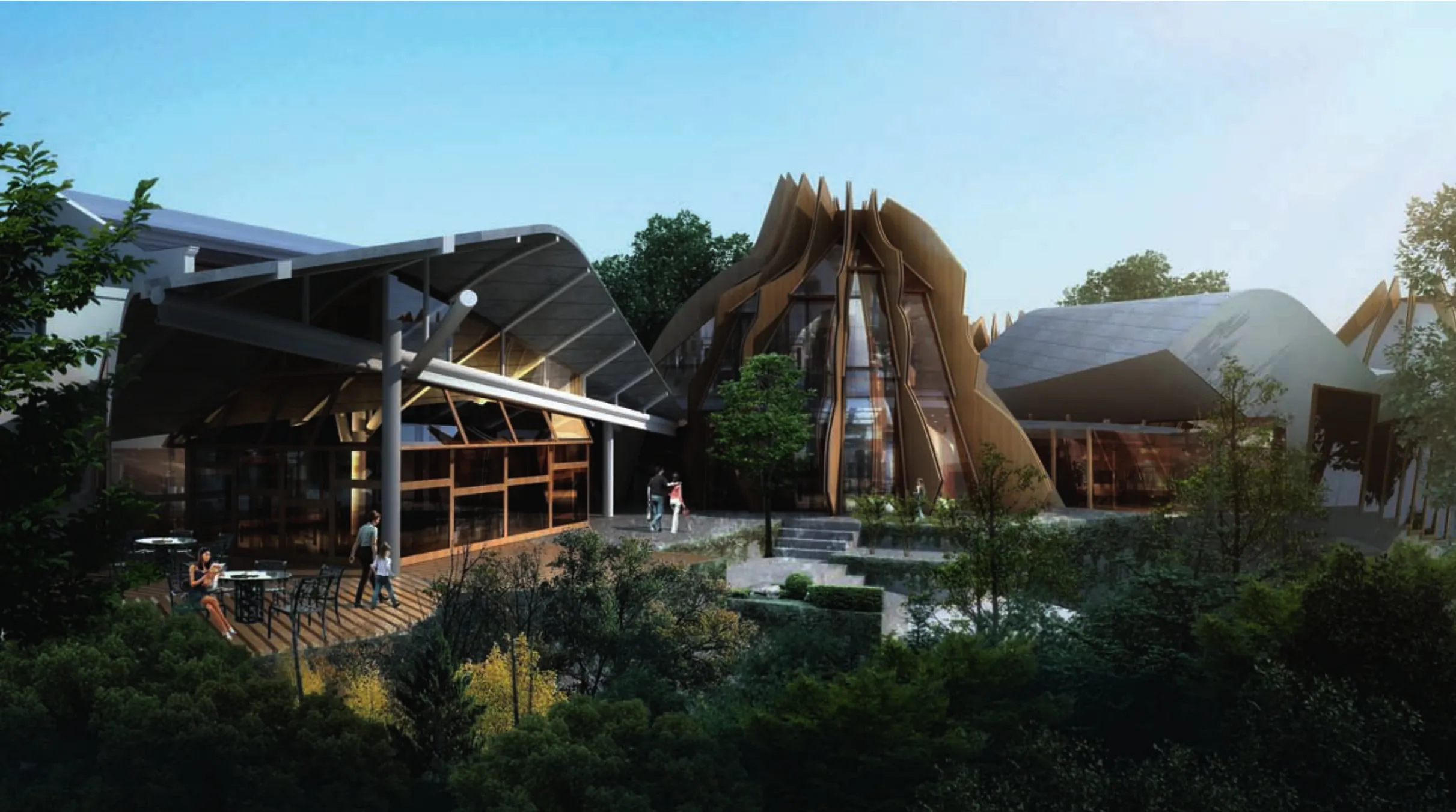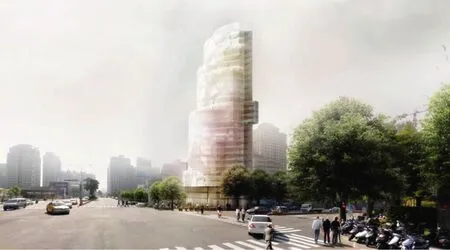贝纳德塔·达格利亚布艾访谈
2017-08-16叶扬,王欣欣,李璠
贝纳德塔·达格利亚布艾访谈
2017年5月底,在贝纳德塔·达格利亚布艾作为普利兹克建筑奖评委访华之际,《世界建筑》对她进行了简短的采访。
WA: 尽管有一些迟,但我仍然想说,恭喜您成为普利兹克奖的评委。
贝纳德塔·达格利亚布艾(BT): 谢谢。
WA: 我们听说您正在行程紧凑的评审团之旅当中,您觉得这次旅行如何?
BT: 这是一次非常开心的旅行。普利兹克评审团的每一次旅行都非常有趣。我们会遇到许多人,有许多新的发现。
WA:旅行中有没有看一些中国建筑?
BT: 我们中有一位中国评委,建筑师张永和。虽然他正逐渐淡出,但是新生代的中国建筑师正在不断涌现,我认为他将会带领我们认识更多值得普利兹克奖关注的新一代中国建筑师。普利兹克奖本身是一个世界性的奖项,很多时候它只能走进五大洲之一。或许许多年前评奖更容易一些,大奖多次被欧洲或美国建筑师获得。现在则完全不同,评审团成员来自不同的大陆,比如澳大利亚、中国、巴西和印度。奖项更多地着眼于世界各国。
WA: 您这次会在中国停留多久?
BT: 我们只在中国停留3天,但是如果算上在日本的行程,这会是一次很长的旅行。
WA: 在您看来,普利兹克奖新评审团的关注点是否存在着转变?
BT: 我认为是的,虽然我自己也是评委中的新面孔。看上去回答“是”是件很容易的事,但实际上并不是这样的。评审团正在适应一个全新的局面,世界更加一体化,不同国籍的建筑师开始到世界的另一端进行设计。中国建筑师也开始受邀到欧洲和美国进行设计。整个行业都在变得更加开放,人们的关注点逐渐转向整个世界共同的问题,而非仅存在于一部分发达地区的问题。所以我认为审查团变得更加关注社会问题,更加关注如何才能让这个全球性的社会更好地运行。我认为这是大家所真正寻求的。WA: RCR 建筑事务所是今年的获奖者。他们的现代建筑风格以当地风土为基础并关注当地有限的建筑材料。您与他们都来自加泰罗尼亚文化,但作品与他们的有很大不同。您的作品具有后现代风格,注入了一种更加国际化的视野,并采取了很多高科技的解决方案。在2010年的上海世博会之后,没有人能够预测您下一个作品会采用什么材料。作为评委,或者作为建筑师,您如何看待这两种不同的趋向?

1 贝纳德塔·达格利亚布艾/Benedetta Tagliabue(摄影/Photo:Lluc Miralles)
BT: 我认为作为一位评委,你需要给予采取与你不同的工作方式的人充分的评价。我们的日本之旅就是一个不错的例子。我与RCR非常熟悉,同时我们又都说加泰罗尼亚语。一起考察建筑作品时,我们时常持有不同的观点。“如果是我设计,我会把这部分去掉。”“这是这个作品最棒的地方,为什么要去掉?”我喜欢这样的争论。
我知道他们的做法有时候非常不同,但我认为作为评委最重要的就是要尽量客观,并真正地看到他人的能力和价值。所以,我认为他们非常特别。他们关注基地、充分利用地形、同时又在需要改变地形时进行彻底的改变,他们的这些设计特质都是我非常欣赏的。我热爱并欣赏他们的作品,即使换成我自己设计时我不会那么做。我认为普利兹克奖是他们应得的。
WA: 您提到评审团应该更多地去关心“大问题”,但是您仍然选择了RCR,这其中的原因是什么?BT: 这是一个很好的问题。你可以说他们的作品不那么具有社会性,但实际上并非如此。比如说,他们决定将事务所设置在郊外。他们离城市很近,事务所最初也是在巴塞罗那创办的,因而他们完全可以继续在城市里工作。然而他们选择留在他们的社区,这就意味着在这个社区当中他们是非常具有社会性的。他们开始为提供周围环境所需要的东西而努力。一名员工的住宅、公园、学校、一位朋友的美丽的餐厅、一座特别的酒店……这些作品并非不像亚历杭德罗·阿拉维纳的作品那样具有很直接的社会性,但在作品本身所在的环境中来看,仍然是具有社会性的。有时他们直接参与作品的建造,亲身砌筑起建筑的一部分,我认为这样的技艺,这种追求有用性和扎根当地的能力是非常具有美感的,我们应当给予这种美感很高的评价。我不认为我们应当永远只把奖颁给那些为帮助这个社会中最贫困的人群而努力的人。建筑具有很多不同的特性,我们需要把这些特性都纳入到考量范围中来,而不是只关注其中的一部分。
WA: 我们于2004年出版了一期EMBT专辑。专辑中您事务所在前15年,完成了一系列出色的项目。这些项目在当时都是崭新而充满激情的。13年后的今天,您的事务所已经成立了将近30年,它的发展历程中有哪些意义重大的阶段?哪些项目对于你们来说是最为重要的?
WA: Maybe it is a bit late, but I still want to say,congratulations on being the member of the Pritzker jury.
Benedetta Tagliabue (BT): Thank you very much.
WA: As we knew, you are in a jury's trip with a very tight schedule. Did you have fun?
BT: Yes. It's lovely. Every trip with the Pritzker jury is very interesting. We met a lot of people, we had discoveries.
WA: Did you have a look at some Chinese architecture?
BT: We had a member of jury who is Chinese,Architect Yung Ho Chang. He is stepping out, but the new Chinese architect is entering so maybe he will make us understand many new generations in China who will be worthwhile for the prize. It's very big, you know, the prize, because it's for the complete world. So sometimes it goes in one of the five continents. Maybe years ago it was easier, it was going in Europe or United States. Now it's very di ff erent and the new jury will have more members from different continents, Australia, China, Brazil,and India. It will be really looking more worldwide.
WA: How many days will you stay in China?
BT: We will be here only three days. But together with the trip to Japan, it will be a very long trip.
WA: In your view, is there a shift of focus in the new Pritzker jury?
BT: I say yes, but I don't know, I have been fresh. It's very easy to say yes but maybe not really.The jury is adapting to the situation; now we have a situation where I think the world is more united, we have architects from different nationalities, working on the other side of the world, and now it's also to be with Chinese architects who start to be invited in Europe and United States. So this is really opening up, and the focus is starting to become more about the problems of the complete world, no not only about the problem of the most the civilized parts of the world, like it used to be, but of everybody. So, in a way I think the jury is more conscious about social problems and how to reinvent the global society in a way that it can function better. I think this is,something that I see everybody really looking for.
WA: RCR Arquitectes was the laureate of this year.Their works have modern architecture style based on local land and focus on the limited materials.It seems different with your works even though both of you are in the Catalan. Your works are postmodern style with a larger international view and using high-tech solutions. After Shanghai Expo 2010, no one knows what is the material in your next project. But how do you understand these two directions as a jury member or an architect?
BT: I understand that being a judge, you have to give credit also to people who work in a way which is not exactly yours. It was kind of nice in these days in Japan. Because with RCR which I know very well and we share the same language. We speak Catalan together. We were looking at the architecture, and we were giving comments, which I was not agreed."This piece of this architecture, I would have taken out." "This is the best one. Why do?" And I like it.
I was thinking, I know they have sometimes a very di ff erent approach, but I think it is important as a member of the jury, to be more objective, and to really value the capacities of other people. So I think they are very special, and they have many qualities which I also appreciate very much of this attention to the site, working with the topography, changing the topography and also being kind of radical in the way of doing. I love their work and appreciate them very much even if I wouldn't do the same. I think they deserve the prize.
WA: As you said, the new jury will care more about the big issues, but you still selected RCR. Why?
BT: Yeah. It could be a question. Because you can say they're not social, but it's not true. For example,the fact that they decided to live outside the city.The city is very near. They started in Barcelona, so it wouldn't have been a problem but they decided to stay in their neighbourhood. It means that they are very social in this neighbourhood. They started to work for what was needed in the surrounding.The house for one of their workers or park or schools, or,then a beautiful restaurant for one of their friends, a special hotel… I mean all of this is really not directly social like it was with Alejandro Aravena, but very social from the place they're acting. Sometimes they worked themselves, there they are themselves physically doing parts of their architecture, so I think this craft, and this capacity of being useful whatever you are, and staying wherever you are,is something beautiful, I think we have to value this is so much. I don't think we have to go on and give prizes all the time to people who are doing everything in terms of helping socially the poorest.Architecture has many qualities, and we have to take them in account, that it's not only doing a part of it.
WA: We published an issue of EMBT in 2004. In the first 15 years, EMBT finished a lot of brilliant projects. They were fresh new and filled with passion. By now, after 13 years, almost 30 years since your firm founded, do you think you have some signi fi cant phases in the developing process?Which projects are most important to you?
BT: My partner died in 2000 so by now it's 17 years.I think it's certainly something that I was always kind of avoiding the same question: Where are you going now? When the tragedy happened that he died, I said I don't know, I'm going in the same direction. By going the same direction, it is just finding new paths, and when you fi nd it just follow them. So you fi nd yourself in different direction if you look back. And now little by little we were moving in the realm of public competitions, public work, and I think now we are very much into structures, working on public structures,which have a very important focus, in the people, in what happens in the surrounding, how architecture is a ff ecting the feelings of everybody. So, I think this is something which is, now my main focus or our main focus in the office, probably it was also before, but now we are more conscious, for example we are working on a subway station, in a very difficult part of Paris, in the outskirt. I think it is really not only about making a station or a beautiful station, but also the making of space and surrounding, where the people can really feel. It is the place that they belong to, and you know this kind of pride of being part of the place, instead of the opposite, which is the course of social discontent.So we are very much into this.In this sense for example, we are working on the subway stations both in Paris and in Naples. In both places, we were also collaborating with other artists.This is very nice because we were talking about social, being social, I think art can be very social, can have a very important function for people, and it's not a super fi cial way, is something very important.In Naples, we have one of the station of a line which is already in use, and it's very evident, Naples is a very wonderful city, a city which has destroyed itself,when they fi nd a beautiful piece of architecture with a fantastic piece of art, there is an incredible respect happening, and these stations are treated as jewels by the citizens. It is really incredible.
BT: 我的合伙人在17年前,也就是2000年去世了。这件事对我的影响很大,以至于我似乎总是在回避同一个问题:你将走向何方?悲剧刚刚发生时,我回答说我不知道,我还是会沿着原来的方向走下去。继续坚持原有方向意味着需要寻找新的路径,一旦找到了就沿着这条路一直走下去。如果回头,你就会发现你已经走向了一个不同的方向。现在我们逐渐投入到公共空间的竞赛和公共项目当中。我们热爱公共构筑物,因为这样的工作聚焦于人,关注周遭发生的事物,关注建筑给所有人的感受带来的变化。可能我们过去也关注过这一方面,但是现在这种意识更为强烈。比如,我们现在正在设计的一座地铁站,它位于巴黎郊外一个很棘手的区域。我认为这个项目的目的不仅是建造一座车站或者建造一座美丽的车站,还在于创造一个人们能够真正感受到的空间和环境。人们应当能够在这里找到归属感,找到成为这个空间的一部分所带来的自豪感。而在无法找到这样的归属感和自豪感时,社会性的不满才会发生。因此,我们热爱这样的工作。
我们实际上在巴黎和那不勒斯同时进行着地铁站的设计。这两个项目中,我们都与不同的艺术家进行了合作。这也是一件非常好的事情。我们一直在谈论社会性,体现社会性,而艺术则具有很高的社会性,能够对人产生很大的影响,而且是深层次的影响,这是非常重要的。我们在那不勒斯所设计的车站位于一条已经开通的线路上。那不勒斯是一座非常美丽的城市,同时又是一座曾经遭到严重破坏的城市。因此当人们发现一座与精美的艺术融为一体的美妙建筑时,他们会展现出惊人的尊重。这些车站被市民们当作珍宝,令人感到万分惊喜。
WA: 当您获得英国皇家建筑师学会的查尔斯·詹克斯奖时,他用“复合了多种形式观的凝集型建筑”来表达您的作品中艺术与建筑形式之间的关系。您怎么看这一评价?
BT: 我认为建筑本身就是一种艺术,所以无论你采取什么方式创造建筑,它都有艺术的一面。这也取决于是让艺术具有自身的价值,还是让它成为你即将建造的建筑所具有的整体价值的一部分。因此,人们可以从不同的角度对两者之间的关系进行诠释,而RCR或者我们的做法正是其中的一种。比如,我们都认为从艺术的角度来看,建造也具有其自身的价值,我坚信这一点。我非常感谢查尔斯·詹克斯所给予的评价。

2 克里希-孟费21地铁站,巴黎,法国/21 Clichy-Montfermeil Metro Station, Paris, France
WA: 您也有一个中国项目,是著名艺术家张大千的博物馆。这座博物馆的主题是艺术。您在中国是否获得了一些特殊的想法和体验?

3 那不勒斯地铁中央站,那不勒斯,意大利,2017/Naples Underground Central Station, Naples, Italy, 2017(2.3图片来源/Image courtesy: EMBT)

4 张大千美术馆,内江,中国/ZHANG Daqian Museum, Neijiang(图片来源/Image courtesy: EMBT)
BT: 我希望这座博物馆能够顺利地建成,它应该会很棒。因为我们只进行了概念设计而且几乎不可能进行更多常规的工地指导。我们尽可能做到最好,却也无法超越我们的能力范围,更无法超越博物馆的馆藏本身。我们试图用一种轻松的方式来诠释张大千,就像他用一种轻松的态度来理解世界并不断发现惊喜的过程一样。这也是我爱张大千的一点。他总是在进行创造并不断感受到每一个事物所带来的惊喜。他的绘画作品是那么美,并且总是在向观者讲述超越画中事物的更多东西。他是一位出色的艺术家,因此,我们为他设计的博物馆是轻松的,一种不同于幽默的轻松。它并不是一栋建筑,也不是一个集中的大空间,而是清晰地嵌入到景观当中的一系列展馆。这个设计更加注重创造景观本身。当人们看到这一系列展馆时,应当能够将它们视为自然的一部分。它们与基地原有的那些美丽的古树交织在一起,与场地固有的文脉共存。我曾经多次询问馆藏内容是什么,我与一些专家进行了讨论,但我们仍然无从知晓。如果可能,我希望这座小小的博物馆能够展现张大千多种多样的创作方式。比如他设计了自己的住宅和景观,他与他的朋友共同创作,他进行写作并书写了很多美妙的信件,他自己进行烹饪并向他的朋友们解说即将上桌的菜肴。我认为所有这些活动都是艺术,如果这座博物馆能够展现出这一点,它将会非常吸引人。我们为实现这个目标贡献了我们的力量。
WA: When you got RIBA Charles Jencks Award, he said your architecture is "agglutinative architecture"with "compound idea of many forms". It is about art and architectural forms. What's your opinion?
BT: I think architecture is an art, so in whatever way you approach it, there is this artistic part. It's also a question to put it into value or to consider it when you do it as part of the value of the construction you're going to do. So I think then you're interpreting in di ff erent way, in one way like RCR or what we do. Both of us, for example, we know that the value of the construction is also in this artistic point of view. I believe that. I'm very grateful that Charles Jencks gave this description.
WA: You have a project in China, a museum for ZHANG Daqian who is a famous artist. The museum is about art. Are there any special ideas and experience in China?
BT: I hope this museum will be well-constructed and it will be nice. Because we just gave the concept and it was not possible to do much more to have regular site supervision. We do our best, but we don't have the possibility to be very much on top of that, especially on top of the content. But I think we are trying to interpret ZHANG Daqian in a kind of light way of understanding the world or this kind of surprise. I love ZHANG Daqian about this. He was always kind of inventing things and totally surprised about everything. You look at his paintings, they are so beautiful, they tell you more than what would you fi nd them. He is a fantastic artist, so we did a project which is not humoristic but kind of light-hearted.It's not one building, or one big place. It's a series of pavilions so it is very clear that it's something which is inserted in the landscape. It's more about the making landscapes themselves. When I look at the pavilions, they could be pieces of nature in a way.They are mingled with beautiful trees because in that place you have very high old trees, so it's about being together with that. I asked many times what will be the content, we still don't know I introduced some experts or but it's not easy to have control over that, I would like this this small museum, if possible, to explain the many di ff erent ways of the artist ZHANG Daqian's work. He was working with landscape, for example, he was doing his own houses and the landscape. He was working with his friends,he was writing things and making beautiful letters,he was working with food, he was explaining to his friends what they were going to eat and then he was cooking himself. So, I think all of these is art, it would be fantastic to explain these in this museum.And on our side, we tried a little bit to do that.

5 张大千美术馆建设中/Under construction, ZHANG Daqian Museum(摄影/Photo: Arch-Exist)
WA: 这是一个非常有趣的项目,它所在的自然环境也非常令人惊喜。
BT: 是的,它非常特别。一座新建筑可以非常成功,也可能会不那么成功。因为这是一个需要在建造过程中悉心照料的项目,而现在的我们无法做到这一点。我们只能作为观察者来回答这样的提问:这样可以吗?我们只能做到改变一部分颜色,但是……中国的工作方式很不一样,我们也正在学习。
WA: 现在正在建设的项目中,哪一个是您最喜欢的?
BT: 我们现在在台湾有个大规模的项目正在建设之中。它并不是一座真正意义上的社会性建筑,因为业主直接邀请我们为他们设计公司的总部大楼。我们曾在巴塞罗那为一个大公司设计并建造过总部大楼。台湾的这座总部大楼并不仅仅展示这家公司的实力,它一方面是有力量的,另一方面也在试图贡献更多东西,试图对邻里街区、街道、路过它的行人展现出慷慨的一面。这座33层的大楼座落在台中高楼林立的市中心。我们采用尽可能柔软的设计,充分尊重街道和周边环境。它有非常宜人的露台,这些露台的设计尊重室内和室外的人们。整座大楼有些像一棵树,这也源于公司创始人自己的故事。这家公司的创始人在这个项目即将开始时去世,他的儿子告诉我们希望这座大楼看上去像一棵树,因为“树”同时也包含在他父亲的名字里。我们乐于接受这样的挑战,因为我们希望能够创造出更具有现实意义的作品,同时也希望能够将公司本身的记忆融入其中。这座建筑正在逐渐生长,我认为它看起来很棒。
我们还有一个位于复旦大学的项目正在建设当中。这也是一座非常大的建筑综合体,我们希望能够通过这座建筑让大学成为城市的一部分。它的景观不应该仅存在于建筑的外围,更应当延伸到建筑内部来,而我们的设计做到了这一点。我们完全没有参与这个项目的施工阶段,因此我们不知道它现在进展如何。明天我将回到上海,希望能够有时间去看一看。

6 中国信托大厦,台中,中国/Taichung Tower, Taichung, China(图片来源/Image courtesy: EMBT)
WA: 希望听到您的好消息。
BT: 我也很期待。
WA: 您明天晚上将作为演讲嘉宾参加同济大学的论坛。您想要传递什么样的信息?
BT: 我想我会谈谈我曾经也和你谈过的一些问题,有关建筑是如何具有影响力的,建筑如何影响它的使用者,我们如何能够让我们所建造的空间比以往更好,或者为使用者带来比以往更好的使用感受。这些事情听上去似乎很简单,但都需要付出毕生的努力。
WA: 您认为有哪些趋势是建筑师们应当更多关注的?

7 中国信托大厦建设中/Under construction, Taichung Tower(摄影/Photo: Yu Chen Tsao)
BT: 我喜欢在设计过程中关注材料。我对2012年普利兹克奖获得者王澍所做的尝试很感兴趣。我认为一些建筑师的作品非常关注材料和材料本身所具有的能力,并能够不断针对这些能力进行创新。我们仍然需要创新,并且需要在超越实际需求的基础上理解创新本身的意义。□
WA: It's a very interesting project in amazing natural environment
BT: Yeah, it's very special. The new construction could be good or could be not so good, because this is a project maybe that has to be looked after very much, and it's now we cannot do very much. We can observe and they sometimes ask: is it okay?The maximum we can do is changing the colour of something but…. It is a different way in China, so we're learning.
WA: Which project under construction is your favourite?
BT: Now we have a big project under construction in Taiwan. It's not precisely something which is very social, because it was a big company who came and asked us to design their new headquarter. We have done one headquarter for a big company in Barcelona. But it's not corporate in the sense that the building is only showing its power, It's a building which is very powerful, but in the same time tries to give something, try to be generous to the neighbours or to the street or to what you find outside to the passers-by, so we had to design a tower of thirtythree floors, we try to make it as soft as possible,with respect to the street and to the situation ,which is kind of a downtown with high-rises in Taiwan in a tycoon city called Taichung, in a new kind of city centre. And you will have these terraces which are nice and respectful to the people inside but also to the people outside. And the building looks a little bit like a tree. It was also because of a personal story of the founder of the company. So, the founder of the company died very little before we started the project, and the son told us that he would like the building looks a little like a tree, because this was the name of the father. So, it's really very good for us because we love to make something a little realistic,but also in this case we will represent a memory of the company itself. So, this is growing and I think it look nice.
We have a project in Fudan University under construction. This is also a very big complex, where we try to make the university be part of the city so that you have a big landscape not only in the external facade but also coming inside. And the architecture is really working with all of that. We are not involved in the construction at all, so we know nothing.Tomorrow I will go back to Shanghai and maybe we will have the time should go on and give a look.
WA: Hope you have good news.
BT: Let's see.
WA: You would be the lecturer of the forum in Tongji University tomorrow night. What will you try to express?
BT: I think I will try to express a little bit of what I've told you before, about how architecture can be in fl uential, how architecture can be in fl uential with the people who use them, and how we can try our best to make the space we build better than it was before, or making the feeling of the people who use them better.This seems very simple but I think it's a work for a lifetime.
WA: Which tendencies should be paid with more attentions to by architects?
BT: I like very much working with attention with materials, for example, the Pritzker laurate WANG Shu in 2012. I'm very interested about what he does and I think some other people do this kind of work of being very attentive about the materials of architecture, about its capacities and being able to innovate in that. We still have to innovate and to try to be always on top of the necessity to understand what the innovation should be.
Interview with Benedetta Tagliabue
叶扬 采访/Interviewed by YE Yang
王欣欣 校/Proofread by WANG Xinxin
李璠 译/Translated by LI Fan

8 复旦大学管理学院,上海,中国/Campus of Fudan School of Management, Shanghai, China(图片来源/Image courtesy:EMBT)
